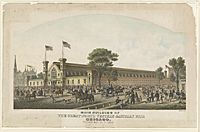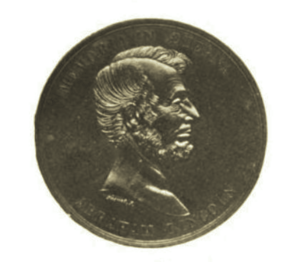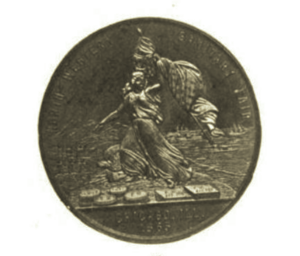Northwestern Sanitary Fair facts for kids

Main fair building
|
|
| Date | March 30 – June 24, 1865 |
|---|---|
| Venue | Northwestern Sanitary Fair building |
| Location | Dearborn Park, Chicago, Illinois |
| Type | Fair |
| Cause | Civil War |
| Motive | Raise funds and supplies for the Union Army |
| Target | American citizens |
| Organised by | United States Sanitary Commission |
| Outcome | net proceeds, US$400,000 |
The Northwestern Sanitary Fair was a special event held in Chicago, Illinois. It was organized by the United States Sanitary Commission (USSC). This group helped soldiers during the American Civil War. The fair opened on May 30 and closed on June 21, 1865.
This was the second time Chicago hosted such a fair. The first one was in 1863. Even though the Civil War had just ended, there was still a big need for money. These funds helped care for soldiers from the Union Army who were injured or disabled.
Contents
History of the Fair
To plan the fair, a special group was formed. It included Mrs. Hoge, Mrs. Livermore, and Mrs. Blatchford from the USSC. They worked with Mrs. Hosmer, Mrs. Dickenson, and Mr. Bryan from the Soldiers' Home. Later, more people joined the main committee. Hon. Mark Skinner became the President. Mr. E. W. Blatchford was the Treasurer and Secretary. Mrs. Hoge and Mrs. Livermore were also important secretaries.
At first, organizers hoped to open the fair on February 22, Washington's birthday. But they had to delay it until May 30. On January 16, 1865, the plan for the fair was officially approved.
The opening ceremony was led by Hon. T. B. Bryan. A poet named Mr. Buchanan Read read a special poem. A hymn written by O. W. Holmes was also read. But it couldn't be sung because the building was so full of people! Instead, a band played music. Governor Oglesby gave a speech. Then, the 8th Reserve Corps band played more music, ending the ceremony.
Two very exciting moments happened during the fair. General Sherman visited on one day. Later, General Grant also came to see the fair.
The fair's daytime exhibits closed on June 20. After that, it was only open in the evenings. But many people still came until the very end. The fair officially closed on June 24.
The fair raised about US$400,000 after all costs were paid. Other Sanitary Fairs across the country raised even more money. Together, they collected nearly US$5,000,000 for the soldiers.
Fair Buildings and Design
Main Building Details
Organizers wanted to have a special ceremony to lay the first stone of the main building. But on that day, sad news arrived: President Abraham Lincoln had been killed. So, construction of the main building began quietly. People at the time said it was the biggest building of its kind ever built in Chicago. Still, some worried it wouldn't be big enough for the fair. Mr. T. Menard built it, with Mr. A. Bauer as the architect.
The main building covered all of Dearborn Park. It was 385 feet long and 162 feet wide. It had three separate halls, connected by passages at the ends and in the middle. Everything was under one large roof.
The middle hall was 385 feet long. It had a gothic arch shape, 60 feet wide at the bottom. It reached almost 50 feet high in the center. This hall was held up by 23 large arches.
Two smaller halls were on each side of the main hall. They were 43 feet wide. Their roofs rose from 12 feet high at the edges to 16 feet high in the middle. Three other halls connected the main and side halls. These were 43 feet wide and 62 feet long. They stretched across the entire width of the building.
There was an 8-foot space between the main and side buildings. This allowed light to come in through many windows. The main building also had 48 windows in its arched roof, 30 feet from the ground. A 7-foot wide open space at the very top of the main building helped with light and air. The side buildings also had similar ways for light and air to enter. More windows, 3 by 7 feet, were around the entire building, 8 feet from the ground.
The building had several doors for people to enter and leave. The main entrance was on Washington Street, in the middle of the building. This doorway was 12 feet wide. Stained glass windows were on each side of the doors. Two frame towers, 60 feet tall, stood near the main entrance. They had flagpoles on top, flying the national flag. A large stained glass window, 25 feet high, was above the main entrance. An eagle, 6 feet tall, sat above the main arch, holding a large shield. Smaller towers, 30 feet high, were at the corners of the building on Washington Street.
The building used 400,000 feet of timber. The wood and building work cost US$19,000, not including the roof. The roof was 70,000 square feet and covered with felt to make it waterproof.
Other Fair Locations
The fair was so big that it was spread out in different parts of Chicago. This made it hard to see everything in one day. For example, Union Hall and Bryan Hall were about a mile apart. Other special exhibits were also scattered around the city, not all under one roof. The art sections included a Picture Gallery and a Horticultural Hall for plants.
Amazing Contributions
People from all over the world sent items to the fair! Contributions came from England, France, Germany, Switzerland, Italy, Denmark, Sweden, Norway, China, and Japan.
General Grant gave "Jack," the horse he rode when he was a colonel. Farmers in Iowa donated 400 acres of land. Even Abraham Lincoln's original log cabin was brought to the fair and set up!
Famous artists and writers also contributed. Harriet Hosmer sent her statue of Zenobia. Carpenter sent his painting of "The Signing of the Emancipation Proclamation." Bierstadt sent his painting of "The Rocky Mountains." Professor Goldwin Smith gave a valuable painting. Many famous writers sent their original handwritten works. Bryan Hall was decorated with flags and showed many unique historical items.
Fair Medal
A special bronze medal was made in early 1865 to remember the Sanitary Fair. It was 57 mm wide.
The front side of the medal said "MEMORIAM IN AETERNAM" (which means "In Eternal Memory"). It showed a picture of President Lincoln's head. A strange thing happened with this medal. After only a few were made, a crack appeared in the metal mold. This crack went across Lincoln's head in the exact spot where the assassin's bullet hit him on April 14, 1865.
The back side of the medal showed a symbolic picture. It said "NORTH WESTERN SANITARY FAIR." It showed Columbia, a female figure representing America, holding a large flag. On the right, there was a lake with ships. On the left, there was a camp and a mountain with the sun rising. In front, there were barrels and boxes of goods. At the bottom, it said "CHICAGO, ILL | 1865."
Voice of the Fair Newspaper
A daily newspaper called Voice of the Fair was published by the fair's organizers. It helped record the fair's progress and became a popular part of the event. All the money made from the newspaper went to help the soldiers.
Many famous writers and important people promised to write for the paper. These included poets like Bryant, Whittier, Longfellow, and Holmes. Also, famous speakers like H. W. Beecher and Artemus Ward. Even President Johnson and important government officials like Mr. Stanton and Secretary Welles agreed to contribute. Generals Grant, Sherman, and Sheridan also promised to write something. Among the women writers were Mrs. Stowe, Grace Greenwood, Gail Hamilton, and Anna Dickinson. Governors Oglesby of Illinois and Stone of Iowa also wrote for the paper. From June 16 until the fair closed, the newspaper was published twice a week instead of daily.




